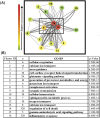A Rich-Club Organization in Brain Ischemia Protein Interaction Network
- PMID: 26310627
- PMCID: PMC4550934
- DOI: 10.1038/srep13513
A Rich-Club Organization in Brain Ischemia Protein Interaction Network
Abstract
Ischemic stroke involves multiple pathophysiological mechanisms with complex interactions. Efforts to decipher those mechanisms and understand the evolution of cerebral injury is key for developing successful interventions. In an innovative approach, we use literature mining, natural language processing and systems biology tools to construct, annotate and curate a brain ischemia interactome. The curated interactome includes proteins that are deregulated after cerebral ischemia in human and experimental stroke. Network analysis of the interactome revealed a rich-club organization indicating the presence of a densely interconnected hub structure of prominent contributors to disease pathogenesis. Functional annotation of the interactome uncovered prominent pathways and highlighted the critical role of the complement and coagulation cascade in the initiation and amplification of injury starting by activation of the rich-club. We performed an in-silico screen for putative interventions that have pleiotropic effects on rich-club components and we identified estrogen as a prominent candidate. Our findings show that complex network analysis of disease related interactomes may lead to a better understanding of pathogenic mechanisms and provide cost-effective and mechanism-based discovery of candidate therapeutics.
Figures






References
MeSH terms
Substances
Grants and funding
LinkOut - more resources
Full Text Sources
Other Literature Sources

